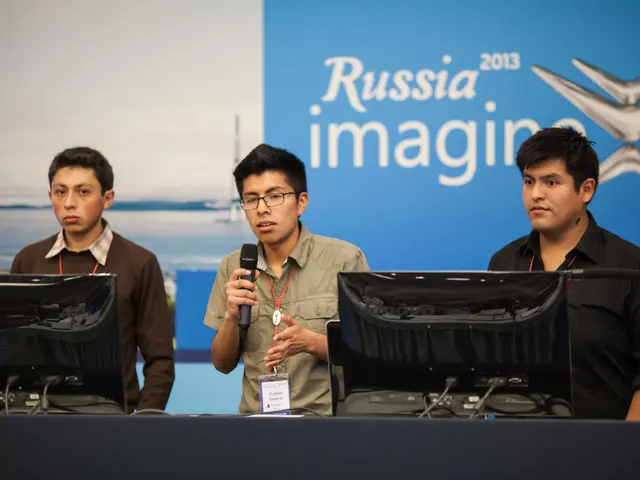Opinion Piece: Tactical Adjustment
In a significant move, India is recalibrating its trade and geopolitical relations, emphasizing greater self-reliance and regional cooperation under the BRICS (Brazil, Russia, India, China, and South Africa) bloc. This strategic pivot, which has strengthened India's ties within BRICS, is also causing the country to be more cautious and less dependent on the US.
Within BRICS, India is actively working to reduce its reliance on the US dollar for trade. The country is promoting the use of the Indian rupee for bilateral trade settlements, a more pragmatic move than the previously discussed single BRICS currency plan. This strategy allows for more feasible, bilateral currency swap arrangements that lower transaction costs and foreign exchange risk. India has already signed agreements with countries like the Maldives and the UAE and is negotiating similar arrangements with others in Asia and Africa.
India's relations with China and Russia within BRICS have been particularly strengthened. India and China have improved diplomatic and economic ties since 2024, resolving some border tensions and promoting technology investment to boost India’s manufacturing capabilities. This rapprochement was encouraged by BRICS summits and diplomatic efforts—especially those led by Russia, which maintains strong relations with both countries. India and Russia are simultaneously looking to increase their bilateral trade to $100 billion over the next five years by reducing tariffs and trade barriers.
While India's relationship with the US remains important, recent US trade tariffs and rhetoric have pushed India to reconsider the extent of its economic dependence on the US. India's emphasis on a “self-reliant India” policy reflects concern over vulnerabilities exposed by both China's trade restrictions and the unpredictability of US trade policies. As a result, India seeks to diversify its trade relationships and reduce exposure to US-driven economic risks, while still maintaining significant strategic ties with Washington.
This shift has deepened India’s partnership with Russia and China, helping mend historic tensions with China and bolstering a multi-polar global trade system less dominated by the US dollar. At the same time, India balances this pivot by maintaining a pragmatic relationship with the US but with an expressed desire to lessen over-dependence through self-reliance and diversified partnerships.
This strategic recalibration towards BRICS has significant implications. It signals India's intent to reduce dollar dominance and the influence of Western economic powers. It also opens up alternative markets for India, as revitalising ties with other partners becomes crucial. However, India still maintains its position to engage in a reasonable dialogue with the US to work out a Bilateral Trade Agreement (BTA).
The prospects of a mutually beneficial trade treaty with the US have receded due to President Trump's intransigence and unilateral imposition of unreasonable tariffs on India. Defence Minister Rajnath Singh obliquely criticised Trump's bullying tactics at a public rally. The strained relationship between India and the US is due to various factors, including Trump's bullying tactics, tariffs, and interference in India's sovereign matters.
In a notable development, Prime Minister Narendra Modi held a one-hour-long meeting with President Luiz Inacio Lula da Silva of Brazil, discussing ways to boost bilateral trade from $12 billion to $20 billion annually. Modi also spoke with Russian President Vladimir Putin and reaffirmed India’s commitment to further deepen the India-Russia Special and Privileged Strategic Partnership.
Moreover, Modi's first visit to China after seven years signals a potential shift in India's geo-political ties. If India were to impose an export duty on generic drugs exports to the US, the increased health costs in the run-up to 2026 mid-term elections would certainly hurt. Putin's possible visit to New Delhi for the India-Russia summit later this year is a sign of the strengthening relationship.
In summary, India's strategic recalibration towards BRICS has strengthened its trade and geopolitical relations with BRICS members, particularly Russia and China, through currency internationalization and trade expansion. This has caused India to be more cautious and less dependent on the US, driven by tariff concerns and geopolitical tensions, while still maintaining important ties with Washington.
- India is actively promoting the use of the Indian rupee for bilateral trade settlements within BRICS, using a more practical approach than the previously discussed single BRICS currency plan.
- India and China have improved their diplomatic and economic ties since 2024, resolving some border tensions and promoting technology investment to boost India’s manufacturing capabilities.
- India and Russia are seeking to increase their bilateral trade to $100 billion over the next five years by reducing tariffs and trade barriers.
- India's emphasis on a “self-reliant India” policy reflects concern over vulnerabilities exposed by both China's trade restrictions and the unpredictability of US trade policies.
- This strategic recalibration towards BRICS has opened up alternative markets for India, as revitalising ties with other partners becomes crucial.
- Prime Minister Narendra Modi's first visit to China after seven years signals a potential shift in India's geopolitical ties, and Putin's possible visit to New Delhi for the India-Russia summit later this year is a sign of the strengthening relationship.





